The coronavirus pandemic has taught us many valuable lessons this year, and perhaps foremost among them is the importance of science.
Researchers at the Department of Energy’s Lawrence Berkeley National Laboratory (Berkeley Lab) have always strived to find science-based solutions for society’s most pressing issues. This year our scientists, while continuing to focus on the immense challenges of energy, climate change, and understanding the mysteries of the universe, also stepped up to face an unprecedented health crisis, using their expertise in everything from nanoscience to machine learning to contribute new knowledge to COVID-19.
In some cases, their pursuit to answer big questions on energy, environment, and health led them to very specific questions, such as why are carp scales so tough yet flexible and how do your genes affect your relationship with coffee. And we found time to celebrate some honors, such as nine new AAAS fellows and our 14th Nobel Prize.
Berkeley Lab’s 10 most popular news stories of the year are as follows.

To address PPE shortages during the pandemic, scientists at Berkeley Lab and UC Berkeley are developing a rechargeable, reusable, anti-COVID N95 mask and a 3D-printable silicon-cast mask mold. (Credit: UC Berkeley)
Two Berkeley Lab materials scientists used their expertise in nanoscience to come up with a better face mask. With the N95 mask – a must-have piece of PPE (personal protective equipment) for front-line workers – in short supply and being re-used over and over, far beyond its recommended lifetime, Jeff Urban and Peter Hosemann designed a reusable silicone N95 mask with a rechargeable, wire-mesh active filter. The rechargeable filter extends its lifetime, and the silicone body allows for a better fit as well as the ability to be made by a 3D printer. “The ultimate vision is to make a mask with a filter battery cartridge that you could plug in and recharge overnight, like a cell phone,” Hosemann said.

Diabolical ironclad beetles are notoriously sturdy, and have been known to walk away after being run over by a car. This illustration shows a car tire and a diabolical ironclad beetle. (Credit: Jesus Rivera/UC Irvine)
Year in Review: Photos
View highlights of 2020 by Berkeley Lab photographers.
Year in Review: Videos
Some of our most popular videos of 2020 were:
National Nano Day: Molecular Foundry Director chats with 4 students ![]()
Berkeley Lab in the Fight: Researching a Probiotic Vaccine for COVID-19![]()
Mother Nature is constantly surprising us. It turns out that the diabolical ironclad beetle is incredibly crush-resistant, thanks to the architecture of its exoskeleton. Understanding this material in microscopic details could allow us to design tougher materials and stronger connections between different material types. Using advanced X-ray techniques at Berkeley Lab’s Advanced Light Source, researchers were able to see the beetle’s microscopic architecture – and especially the areas with interlocking parts – at different stages of compression. They found this insect can withstand compression of up to 39,000 times its body weight. The study was published in Nature.

A view of the San Francisco Bay Area from Berkeley Lab during the 2018 Camp fire (left) and three weeks prior. The graphs show PM2.5 concentrations (microgram per cubic meter), with the x-axis as measured by the regulatory monitor in downtown Berkeley and the y-axis as measured by PurpleAir monitors. On the good air day, the numbers were roughly the same. However, when wildfire smoke was present the PurpleAir readings were consistently far higher than the regulatory monitor’s. (Photo credit: Kelly J. Owen/Berkeley Lab)
The coronavirus was not the only disaster of 2020. Wildfires across the western U.S. burned more than 9 million acres and set records from Colorado to Oregon. As many people were staying home more, indoor air quality suddenly became an urgent issue. Berkeley Lab’s indoor air scientists published a study evaluating several brands of consumer-grade air quality monitors, which have become popular in recent years. Bottom line? “We are impressed and excited by the usefulness and performance of these air quality monitors that cost under $300,” said Brett Singer, head of Berkeley Lab’s Indoor Environment Group.
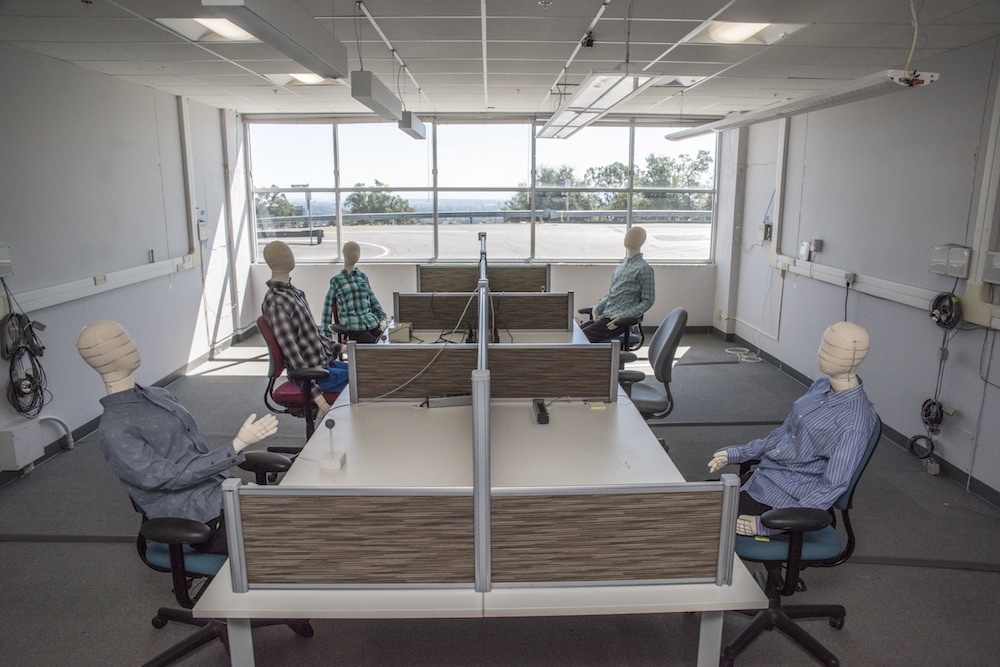
FLEXLAB, the world’s most advanced building simulator and testbed, will be used to simulate office and school heating, ventilation, and air conditioning configurations. (Credit: Berkeley Lab)
One of the top unanswered questions about the novel coronavirus has been to what extent it can stay airborne. A team of Berkeley Lab scientists launched a study of the transport of droplets and aerosols within and between rooms using a combination of simulations and experiments. The research, which is still ongoing, will also be relevant to other viruses, such as the seasonal flu. “The insights generated by this research may be useful for controlling the spread of other respiratory infectious agents that come along in the future,” said Tom Kirchstetter, director of Berkeley Lab’s Energy Analysis and Environmental Impacts Division.
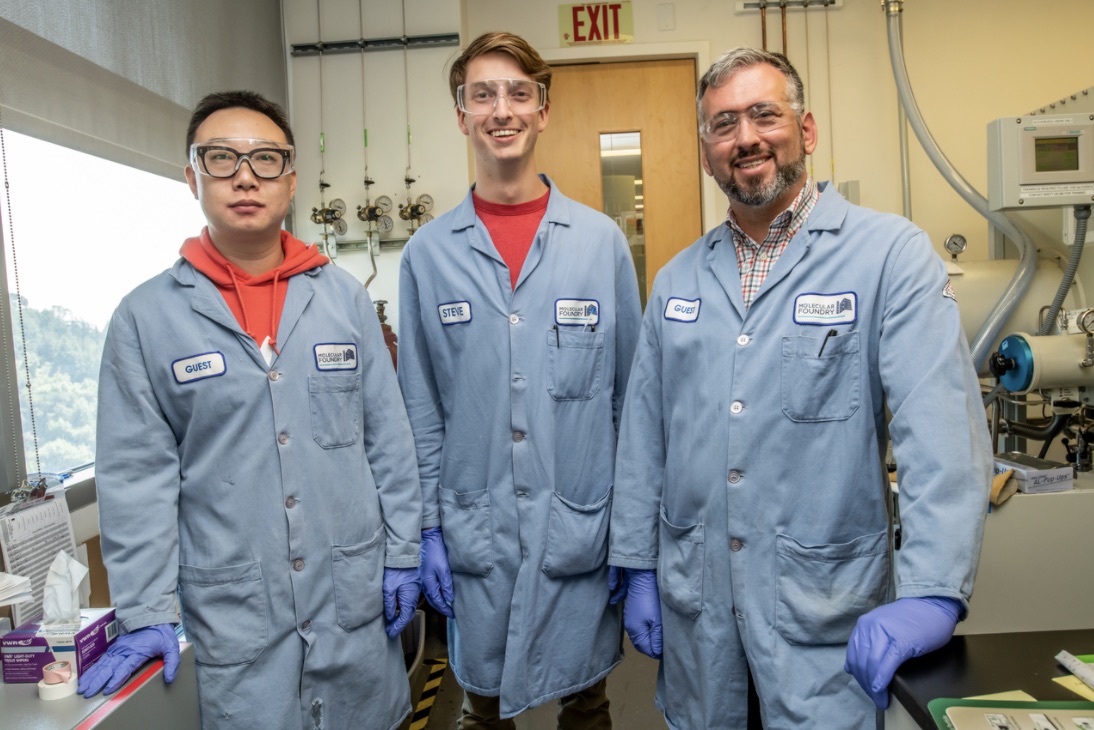
Berkeley Lab researchers (from left) Chengyin Fu, Andrew Ells, and Brett Helms at the Molecular Foundry (Credit: Marilyn Sargent/Berkeley Lab)
Berkeley Lab scientists have been at the forefront of battery research since the 1950s, with some of the earliest breakthroughs that have enabled today’s workhorse energy storage device, the lithium-ion battery. The battery research program has continued to grow and innovate, with advances this year alone in fast-charging batteries and a new technique for battery research. In this breakthrough, researchers reported a new class of soft, solid electrolytes, potentially leading to eVTOL (electric vertical takeoff and landing) aircraft and safe, long-range electric cars. “With [our technology], battery manufacturers can produce safer lithium metal batteries with both high energy density and a long cycle life,” said Molecular Foundry scientist Brett Helms.
Berkeley Lab won its first Nobel Prize in 1939, with the Physics prize going to Lab founder E.O. Lawrence. In the following eight decades, Lab researchers were awarded the prestigious prize 12 more times, mostly in Physics and Chemistry, but until 2020, none of them went to an individual female researcher. Biochemist Jennifer Doudna’s win this year was historic in many ways. Together with Emmanuelle Charpentier, they formed the first all-woman team to win a Nobel Prize, recognized for their development of the CRISPR-Cas9 genetic engineering technology, which has revolutionized biomedicine. In 2008, Doudna, who is also a professor at UC Berkeley, had her nascent research on CRISPR RNA strands and the Cas1 protein funded by a Laboratory Directed Research and Development (LDRD) Program award through her Berkeley Lab affiliation.
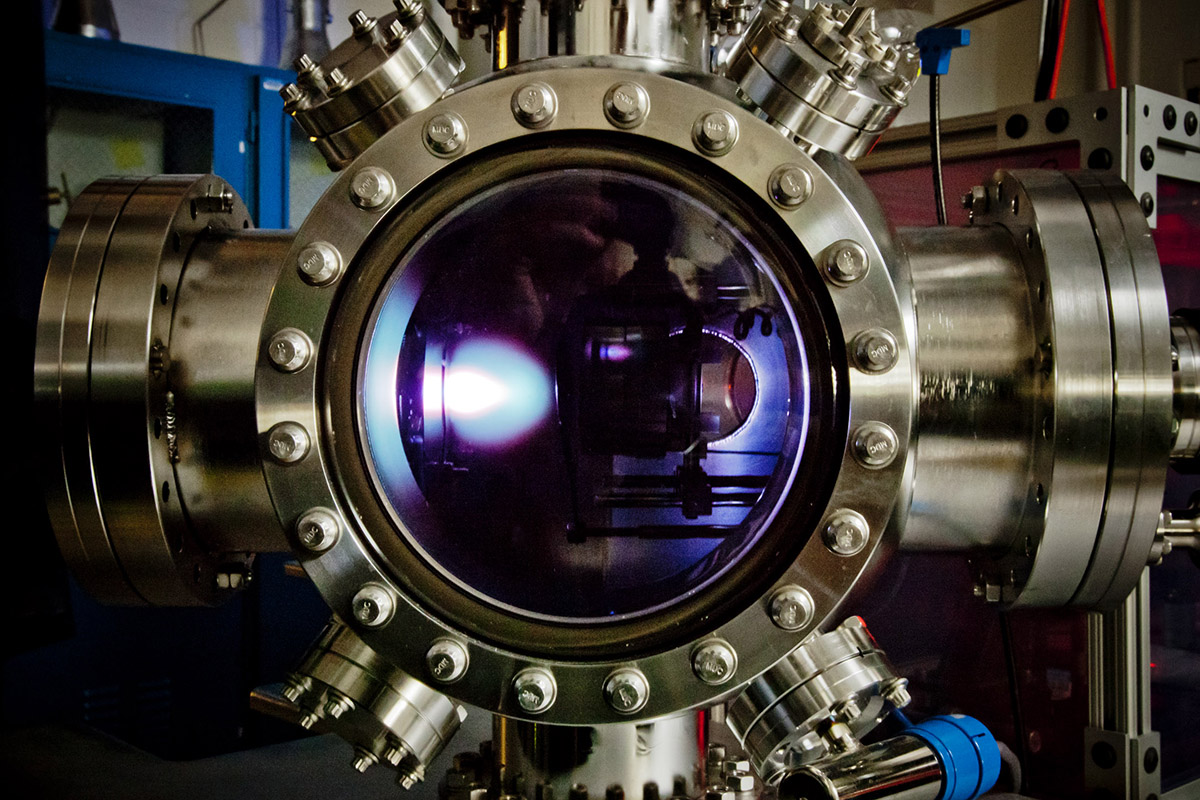
To make the new material, the thin film is first deposited via a pulsed-laser deposition process in this chamber. (Image courtesy of Lane Martin)
The flux capacitor may be the stuff of science fiction dreams, and until recently, so was a capacitor able to both charge and discharge rapidly and store high amounts of energy. Capacitors are commonly used in electronic devices to maintain power supply while a battery is being charged. A discovery by Berkeley Lab scientists, reported in the journal Science, demonstrated that a common material, based on a so-called “relaxor ferroelectric,” can be processed into a top-performing energy storage material. “You’ve probably experienced relaxor ferroelectrics on a gas grill. The button that lights the grill operates a spring-loaded hammer that smacks a piezoelectric crystal, which is a type of relaxor, and creates a voltage that ignites the gas,” said lead researcher Lane Martin. “We’ve demonstrated that they can also be made into some of the best materials for energy-storage applications.”
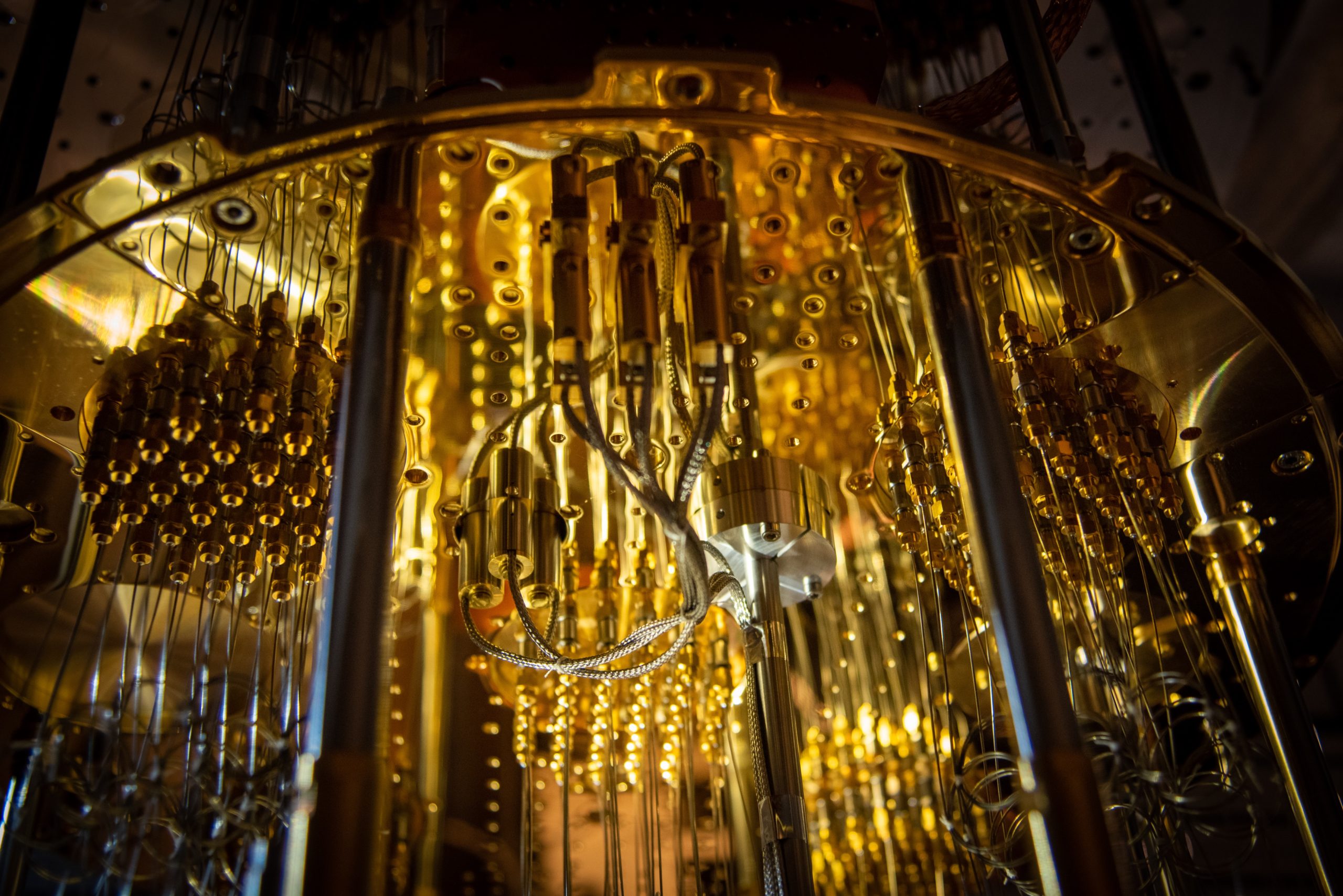
The Quantum Systems Accelerator will optimize a wide range of advanced qubit technologies available today. To keep superconducting circuits used in quantum computers cold enough so scientists can study them, Berkeley Lab uses a sophisticated dilution refrigerator. (Credit: Thor Swift/Berkeley Lab)
The race is on to build quantum computers. In August, the Department of Energy awarded $115 million over five years to the Quantum Systems Accelerator (QSA), a new research center led by Berkeley Lab that brings together dozens of scientists from 15 institutions. QSA is co-designing prototype quantum systems that are optimized for major advances in scientific computing, fundamental physics, materials, and chemistry. “The Quantum Systems Accelerator will transform the enormous promise of quantum entanglement into an engineering resource for the nation, forging the industries of tomorrow,” said QSA Director Irfan Siddiqi. It is one of five new National Quantum Information Science (QIS) Research Centers.
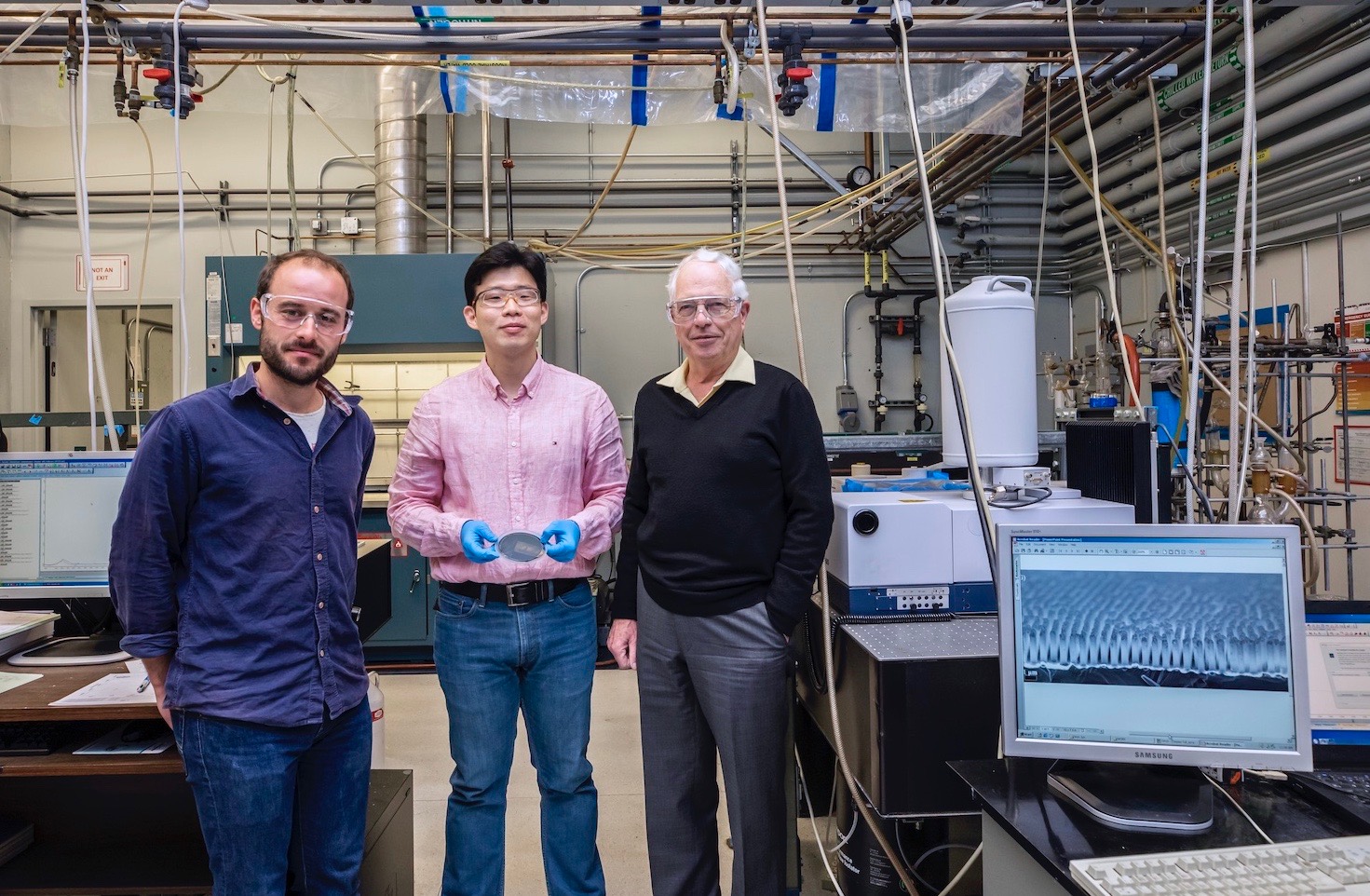
Heinz Frei (right), Georgios Katsoukis (left), and Won Jun Jo, who is holding a small piece of their solar fuel tile material. (Credit: Marilyn Sargent/Berkeley Lab)
Artificial photosynthesis technology has the potential to generate large amounts of completely renewable energy from sunlight, water, and carbon dioxide. In recent years, Berkeley Lab researchers have made many advances in the fundamental chemistry needed to get these engineered systems off the ground. This latest one, led by researcher Heinz Frei, proposes an artificial photosynthesis system made of nanosized tubes, capable of performing all the key steps of the fuel-generating reaction. A complete system would contain billions of the tubes, each splitting water on the inside and producing protons that flow to the outside, where they react with carbon dioxide to form carbon monoxide, and eventually, methanol – a highy versatile liquid fuel.

This image, produced by the Millennium-II Simulation, shows the evolution of dark matter in the universe. (Credit: Milennium-II Simulation)
Scientists know dark matter must make up about 85% of the total mass of the universe, but they don’t yet know what it’s made of. It’s not for lack of trying – several large experiments are hunting for signs of dark matter particles knocking into atomic nuclei via a process known as scattering, which can produce tiny flashes of light and other signals in these interactions. This new study published in Physical Review Letters by Berkeley Lab’s Theory Group proposes that overlooked dark matter signals could be produced, instead, by a process called absorption – and data for these types of interactions could be hiding in previously collected particle detector data, and could also be searched for using existing experiments. “You can make a huge amount of progress with very little cost if you step back a little bit in the way we’ve been thinking about dark matter,” said postdoctoral researcher Jeff Dror.
# # #
Founded in 1931 on the belief that the biggest scientific challenges are best addressed by teams, Lawrence Berkeley National Laboratory and its scientists have been recognized with 14 Nobel Prizes. Today, Berkeley Lab researchers develop sustainable energy and environmental solutions, create useful new materials, advance the frontiers of computing, and probe the mysteries of life, matter, and the universe. Scientists from around the world rely on the Lab’s facilities for their own discovery science. Berkeley Lab is a multiprogram national laboratory, managed by the University of California for the U.S. Department of Energy’s Office of Science.
DOE’s Office of Science is the single largest supporter of basic research in the physical sciences in the United States, and is working to address some of the most pressing challenges of our time. For more information, please visit energy.gov/science.
